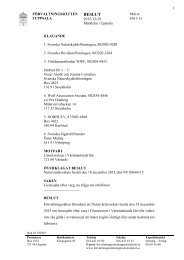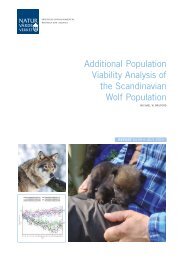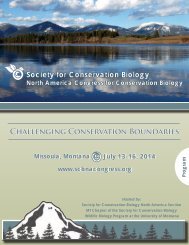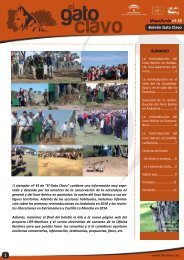1oC3Dbk
1oC3Dbk
1oC3Dbk
Create successful ePaper yourself
Turn your PDF publications into a flip-book with our unique Google optimized e-Paper software.
canids – is the main implementing body of this strategy, which<br />
includes a 10-year National Action Plan. Jointly with the Cat<br />
Specialist Group, the CSG has spearheaded the development<br />
of regional conservation strategies for African wild dogs and<br />
cheetah, since these two species have similar ecological<br />
requirements and face similar threats. Under each regional<br />
strategy we support range countries to prepare their own<br />
national action plans, ably assisted by regional coordinators<br />
recruited by the sponsors of the initiative; the Zoological<br />
Society of London and the Wildlife Conservation Society.<br />
We are in the process of reassessing all canid species for<br />
The IUCN Red List of Threatened Species, with a planned<br />
completion date of 2015. To facilitate the process for a<br />
number of reassessments, we are piloting an online forum<br />
prepared by the SSC, onto which the draft reassessments<br />
have been posted. During 2014 we plan to undertake<br />
assessments on Arctic foxes, dholes, maned wolves and all<br />
the South American foxes, with the view to reassess the<br />
remaining species in 2015.<br />
Our priority is fine-tuning our global network of canid<br />
experts using a working group approach, and promoting the<br />
implementation of Canid Action Plan projects and actions. We<br />
would like to see more bottom-up initiatives and dynamism<br />
amongst the CSG membership.<br />
Dr Claudio Sillero-Zubiri<br />
Chair, Canid Specialist Group<br />
Caprinae Specialist Group<br />
The Caprinae Specialist Group seeks to promote the<br />
conservation of mountain ungulates and their habitat.<br />
Ongoing concerns include habitat degradation, competition<br />
and disease transmission from domestic livestock and<br />
poaching. Many of our efforts are focused on Asia, which has<br />
both the largest number of species and the greatest<br />
conservation problems. For example, several group members<br />
participated in workshops that led to an international Argali<br />
action plan currently under review. In addition, mountainadapted<br />
species face an increasing threat from global<br />
warming; for example, declines in body size in alpine chamois<br />
appear related to warming temperatures in the Alps, although<br />
data on alpine ibex suggest an opposite relationship between<br />
body size and temperature; we clearly still have a lot to learn<br />
about the complex effects of climate change.<br />
Our group has also long been interested in the potential<br />
biological and economic consequences of trophy hunting.<br />
Many caprinae species are highly sought after by trophy<br />
hunters. For example, to hunt some species of wild sheep,<br />
hunters, often foreigners, are willing to pay several tens of<br />
thousands of dollars. This creates both an opportunity to<br />
generate funds for conservation and a concern about possible<br />
artificial selection. Several of our group members are involved<br />
in research on the biological consequences of selective<br />
hunting. We also made a substantial contribution to the recent<br />
publication IUCN Guiding Principles on Trophy Hunting as a<br />
Tool for Creating Conservation Incentives. This publication sets<br />
forth the condition required to make a trophy hunting program<br />
ecologically and evolutionarily sustainable, as well as a positive<br />
contribution to conservation. It builds upon our long-standing<br />
position statement on trophy hunting and has already been<br />
used by conservation agencies to distinguish trophy hunting<br />
operations that do and do not contribute to conservation.<br />
Argali Ram. © Rich Reading<br />
Continuing activities include analyses of long-term data on<br />
both live and hunter-harvested animals, and evaluation of the<br />
conservation status of different species.<br />
Prof. Marco Festa-Bianchet<br />
Chair, Caprinae Specialist Group<br />
Carnivorous Plant Specialist Group<br />
The Carnivorous Plant Specialist Group (CPSG) currently has<br />
a membership of six (including Patron). Our mission is to help<br />
ensure that that the conservation status of all carnivorous<br />
plants are adequately and accurately documented; to assist in<br />
raising public awareness and encourage initiation of<br />
appropriate conservation measures, and to ensure that The<br />
IUCN Red List is updated as quickly as possible, commencing<br />
with those taxa that are currently listed as Data Deficient and<br />
which have been identified by experts within the CPSG as<br />
being most in need of conservation action.<br />
An externally funded project was undertaken by the<br />
CPSG in 2013, with the aim of conducting research to gather<br />
data to facilitate IUCN Red List assessments of 19 Nepenthes<br />
pitcher plant species; all of which were considered threatened<br />
in the wild, and for which adequate, up to date information<br />
about their conservation status was lacking. Of the 19 species<br />
intended for survey, 13 had not been assessed previously.<br />
Five field expeditions were undertaken to various parts of<br />
Southeast Asia during 2013, including Sumatra (two<br />
expeditions), New Guinea, Palawan, Luzon, and Sulawesi.<br />
The project delivered significantly better outcomes than<br />
originally anticipated; a total of 28 Nepenthes species were<br />
surveyed, with 26 receiving new or revised Red List<br />
assessments. All data was entered into the Species<br />
Information Service, along with distribution maps and<br />
supporting documentation and was reviewed by the end of<br />
2013. This project has resulted in new, complete Red List<br />
assessments for more than 15% of all Nepenthes species and<br />
has resulted in a significant reduction in the number of Data<br />
Deficient and therefore Not Evaluated species. This stands us<br />
in good stead to attain our goal of revising the Red List<br />
assessments for all Nepenthes species in the next few years.<br />
One unexpected outcome of these survey expeditions was<br />
the discovery of one, as yet undescribed species of<br />
Nepenthes.<br />
40 IUCN species Annual Report 2013






